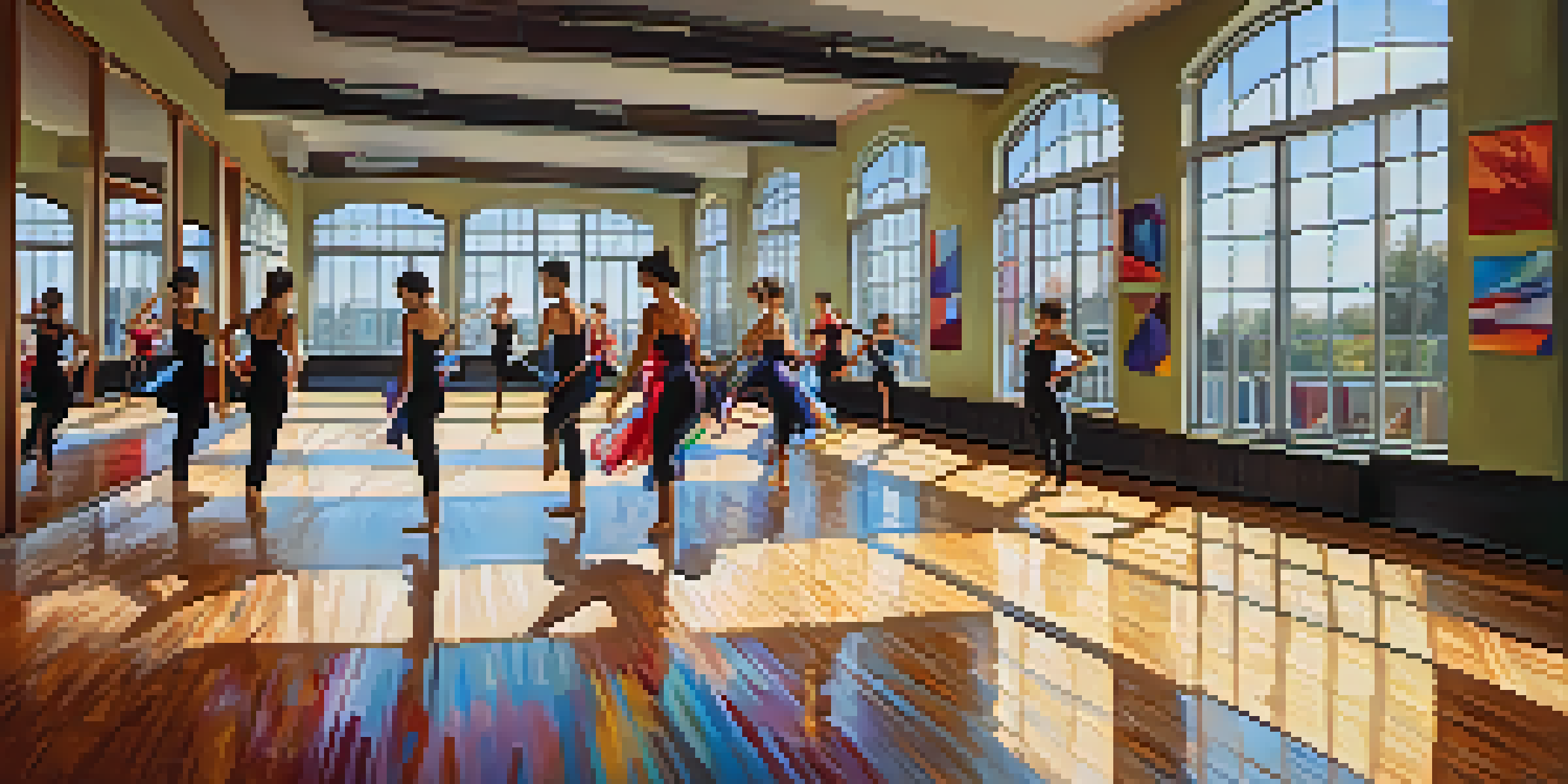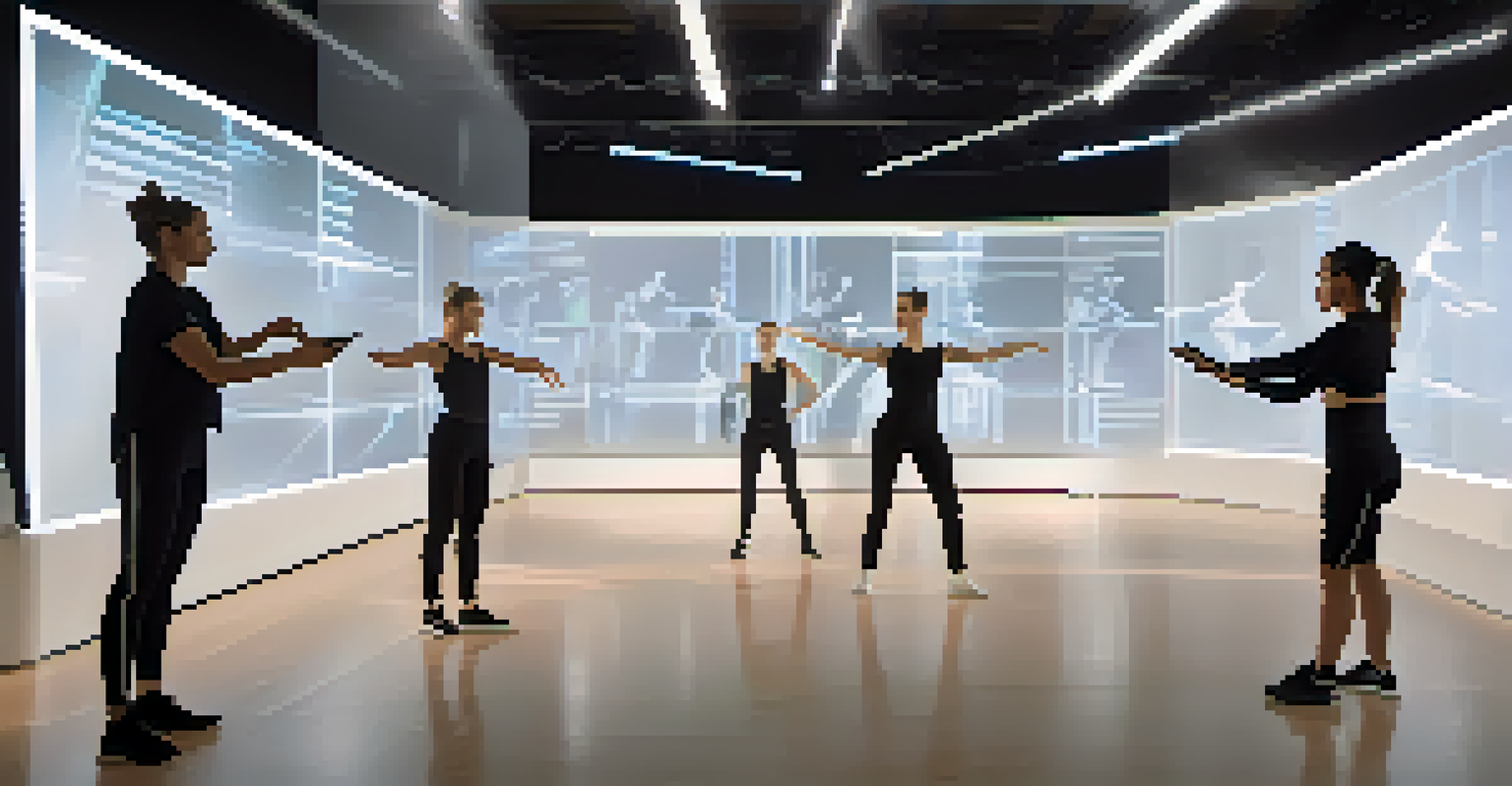The Role of Technology in Modern Choreographic Innovations

The Evolution of Choreography Through Technology
Choreography has undergone significant transformations over the years, largely influenced by technological advancements. From the introduction of video recordings in the early 20th century to the current use of motion capture, technology has changed how dance is created and shared. These tools not only enhance the creative process but also allow choreographers to analyze and refine their work more effectively.
Dance is the hidden language of the soul.
Moreover, technology has democratized access to choreography. Aspiring dancers and choreographers can now learn from online tutorials, watch performances from around the globe, and even collaborate digitally. This wide availability of resources fosters a global community where ideas can flourish and evolve, pushing the boundaries of creativity.
Ultimately, technology serves as both a catalyst and a canvas for innovation in choreography. It enables artists to experiment with new forms and styles, integrating elements that were previously unimaginable. As a result, the landscape of dance continues to expand, inviting audiences and performers alike to explore uncharted territories.
Digital Tools Transforming Choreographic Processes
In today's digital age, various tools have emerged that streamline the choreographic process. Software like DanceForms and Choreographer's Toolkit allows dancers to visualize movements and create intricate dance sequences without extensive physical rehearsals. This not only saves time but also opens up creative possibilities that were once constrained by the limitations of physical practice.

Additionally, apps and platforms provide choreographers with the means to document their work and share it instantly with collaborators. Imagine being able to send a video of a new routine to a dancer halfway across the world in seconds! This ease of communication enhances collaboration and allows for more dynamic and responsive creative processes.
Tech Revolutionizes Dance Creation
Technological advancements have transformed choreography, providing new tools for creation, collaboration, and sharing.
The incorporation of digital tools also means that choreography can be archived and revisited, creating a rich history of dance that future generations can learn from. These resources help ensure that innovative moves and styles are not lost but instead evolve as they are passed down through various artistic lenses.
Interactive Performance: Engaging Audiences Through Tech
Technology has not only influenced how choreography is created, but also how it is experienced by audiences. Interactive performances, where spectators can engage with the dancers through apps or augmented reality, create a unique blend of dance and technology. This engagement transforms passive viewers into active participants, enhancing their emotional connection to the performance.
Technology is the campfire around which we tell our stories.
For instance, some companies have begun incorporating audience feedback in real-time, allowing spectators to influence the choreography as the performance unfolds. This dynamic interaction fosters a sense of community and collective creativity, making each performance a unique experience. It also challenges the traditional hierarchy of performer and audience, blurring the lines between the two.
As technology continues to evolve, so too will the ways in which audiences engage with dance. These innovations not only attract new viewers but also rejuvenate the art form by making it more accessible and relatable, inviting everyone to join in the dance.
The Rise of Virtual Reality in Dance
Virtual reality (VR) is making waves in the dance world, offering immersive experiences that were once purely imaginative. VR allows viewers to step into a virtual environment where they can experience dance from different perspectives, whether as a spectator or even as a participant. This level of immersion creates a new dimension to how dance can be perceived and appreciated.
Moreover, VR technology serves as a powerful training tool for dancers. By simulating various performance scenarios, dancers can practice their craft in a controlled yet dynamic setting. This not only builds confidence but also enhances muscle memory, allowing performers to refine their skills without the pressures of a live audience.
Interactive Dance Engages Audiences
Innovative performances that incorporate audience interaction blur the lines between performer and spectator, enhancing emotional connections.
As more choreographers and companies embrace virtual reality, we can expect to see a surge in innovative performances that blend traditional dance with cutting-edge technology. These experiences will not only captivate audiences but also push the boundaries of what dance can be, inviting us to reimagine our relationship with movement.
The Impact of Social Media on Dance Choreography
Social media platforms have become a powerful tool for choreographers, providing a space to showcase their work and reach wider audiences. With platforms like Instagram and TikTok, dancers can share short clips of their routines, gaining instant feedback and visibility. This exposure can lead to new opportunities and collaborations, further expanding the creative landscape.
Additionally, social media allows for trends in choreography to spread rapidly. A unique dance move or style can go viral overnight, inspiring countless dancers to replicate and innovate upon it. This phenomenon creates a rich tapestry of styles that reflect the collective creativity of the community, often leading to exciting new forms of expression.
However, the fast-paced nature of social media can also pose challenges. Choreographers may feel pressured to create content that is 'shareable' rather than authentic. Striking a balance between artistic integrity and audience engagement is essential, ensuring that creativity remains at the forefront of the dance experience.
Artificial Intelligence: A New Choreographic Partner
Artificial intelligence (AI) is increasingly being integrated into the creative process, acting as a collaborator for choreographers. AI can analyze vast amounts of dance data, suggesting movements and sequences that a choreographer might not have considered. This partnership can inspire fresh ideas and innovative approaches to choreography, making the creative process more diverse.
Some choreographers are even using AI-generated movements as a starting point, allowing technology to push the boundaries of traditional dance forms. By blending human creativity with machine learning, artists can explore new possibilities that challenge the status quo. This fusion creates a fascinating dynamic, where technology enhances, rather than replaces, the artistry of dance.
AI as a Creative Partner in Dance
Artificial intelligence is emerging as a collaborator for choreographers, inspiring new movements and expanding the boundaries of traditional dance.
As AI continues to evolve, its role in choreography will likely become more prominent. This partnership could lead to a new era of dance that embraces both human emotion and technological precision, ultimately enriching the art form as we know it.
The Future of Choreography: Where Technology Meets Art
Looking ahead, the future of choreography seems bright as technology continues to advance. Innovations in robotics, virtual reality, and AI promise to create new avenues for exploration and expression within the field of dance. As choreographers adopt these technologies, we can expect to see a more diverse range of performances that reflect the complexities of our modern world.
The integration of technology also encourages collaboration across different art forms, leading to interdisciplinary projects that blend dance with visual arts, music, and theater. This synergy not only enriches the dance experience but also makes it more accessible to a broader audience. The art of choreography is becoming a rich tapestry woven with various creative threads.

Ultimately, as technology evolves, so too will the language of dance. Choreographers will have the tools to break free from traditional constraints, inviting us all to engage with movement in exciting new ways. The journey of choreography is one of continual innovation, and it’s a thrilling time to be a part of this ever-evolving art form.